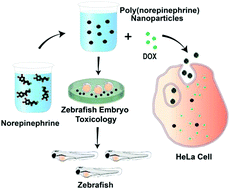Bioinspired polynorepinephrine nanoparticles as an efficient vehicle for enhanced drug delivery†
Abstract
An innovative drug delivery vehicle based on polynorepinephrine (PNE) with controllable size modification, high delivery efficacy and low cytotoxicity is presented. Highly monodisperse PNE nanoparticles are fabricated by the autoxidation of norepinephrine monomers in an alkaline water/ethanol mixture via stirring at room temperature. We demonstrated the facile optimization of particle size to enhance particle stability and biocompatibility by varying solvent and monomer dosage. To demonstrate the suitability and potential application of PNE particles in cancer therapy, we show that these particles are biocompatible in vitro with HeLa cells and in vivo in zebrafish embryos. After loading the anti-cancer chemotherapy drug doxorubicin (DOX) into the PNE nanoparticles, a consistent and pH responsive drug release profile of DOX was achieved in different environmental conditions. It was found that DOX loaded PNE nanoparticles (PNE/DOX) exhibit much higher pharmaceutical cytotoxicity than free DOX on HeLa cells. Furthermore, the amount of drug released was significantly enhanced in acidic environments that mimic the pH of extracellular tumour microenvironments. Taken together, the PNE nanoparticles represent a new class of melanin particles with promising potential in drug delivery and as a therapeutic platform for cancer treatment.



 Please wait while we load your content...
Please wait while we load your content...